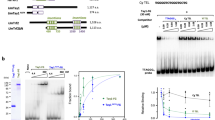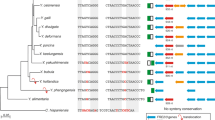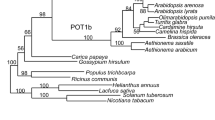Abstract
Telomere-linked RecQ helicase (TLH) genes have been identified in several fungi, where they occur as small gene families with each member copy residing within ~10 kb of a telomere. Here we describe the characterization of all 11 TLH gene copies in the reference strain of the fungus Magnaporthe oryzae. A consensus gene prediction revealed that the previously reported TLH1 gene is actually a mutated copy, and the full-length gene is almost two times longer. Only four full-length TLH genes were present in the strain that was analyzed, with the remaining copies containing premature stops caused by point mutations, indels, transposon insertions, and a telomere truncation. Interestingly, all of the TLH gene copies possessed numerous mutations indicative of the action of the repeat-induced point mutation process. However, there was evidence of purifying selection indicating maintenance of gene function. Alignment of full-length proteins from M. oryzae, Schizosaccharomyces pombe and M. anisopliae revealed the presence of a novel, highly conserved protein motif which suggests that the telomere-linked helicases have different functions and/or substrates to the RecQ helicases encoded by “internal” genes.



Similar content being viewed by others
References
Altschul SF, Gish W, Miller W, Myers EW, Lipman DJ (1990) Basic local alignment search tool. J Mol Biol 213:403–410
Bachrati CZ, Hickson ID (2003) RecQ helicases: suppressors of tumorigenesis and premature aging. Biochem J 374:577–606
Bailey TL, Elkan C (1994) Fitting a mixture model by expectation maximization to discover motifs in biopolymers. Proc Int Conf Intell Syst Mol Biol 2:28–36
Bateman A, Coin L, Durbin R, Finn RD, Hollich V, Griffiths-Jones S, Khanna A, Marshall M, Moxon S, Sonnhammer ELL, Studholme DJ, Yeats C, Eddy SR (2004) The Pfam protein families database. Nucleic Acids Res 32:138–141
Baur JA, Zou Y, Shay JW, Wright WE (2001) Telomere position effect in human cells. Science 292:2075–2077
Birney E, Clamp M, Durbin R (2004) Genewise and Genomewise. Genome Res 14:988–995
Blackburn EH (1990) Telomeres: structure and synthesis. J Biol Chem 265:5919–5921
Cambareri EB, Jensen BC, Schabtach E, Selker EU (1989) Repeat-induced G–C to A–T mutations in Neurospora. Science 244:1571–1575
Chan CSM, Tye BK (1983) A family of Saccharomyces cerevisiae repetitive autonomously replicating sequences that have very similar genomic environments. J Mol Biol 168:505–523
Chao CCT, Ellingboe AH (1991) Selection for mating competence in Magnaporthe grisea pathogenic on rice. Can J Bot 69:2130–2134
Dean RA, Talbot NJ, Ebbole DJ, Farman ML, Mitchell TK, Orbach MJ, Thon M, Kulkarni R, Xu JR, Pan H, Read ND, Lee YH, Carbone I, Brown D, Oh YY, Donofrio N, Jeong JS, Soanes DM, Djonovic S, Kolomiets E, Rehmeyer C, Li W, Harding M, Kim S, Lebrun MH, Bohnert H, Coughlan S, Butler J, Calvo S, Ma LJ, Nicol R, Purcell S, Nusbaum C, Galagan JE, Birren BW (2005) The genome sequence of the rice blast fungus Magnaporthe grisea. Nature 434:980–986
Farman ML, Taura S, Leong SA (1996) The Magnaporthe grisea DNA fingerprinting probe MGR586 contains the 3′ end of an inverted repeat transposon. Mol Gen Genet 251:675–681
Gao W, Khang CH, Park S-Y, Lee Y-H, Kang SK (2002) Evolution and organization of a highly dynamic, subtelomeric helicase gene family in the rice blast fungus Magnaporthe grisea. Genetics 162:103–112
Gorbalenya AE, Koonin EV (1993) Helicases: amino acid sequence comparisons and structure–function relationships. Curr Biol 3:419–429
Gorbalenya AE, Koonin EV, Donchenko AP, Blinov VM (1989) Two related superfamilies of putative helicases involved in replication, recombination, repair, and expression of DNA and RNA genomes. Nucleic Acids Res 17:4713–4730
Gottschling DE, Aparicio OM, Billington BL, Zakian VA (1990) Position effect at S. cerevisiae telomeres: reversible repression of Pol II transcription. Cell 64:751–762
Higgins D, Thompson J, Gibson T, Thompson JD, Higgins DG, Gibson TJ (1994) CLUSTAL W: improving the sensitivity of progressive multiple sequence alignment through sequence weighting, position-specific gap penalties and weight matrix choice. Nucleic Acids Res 22:4673–4680
Ikeda K, Nakayashiki H, Kataoka T, Tamba H, Hashimoto Y, Tosa Y, Mayama S (2002) Repeat-induced point mutation (RIP) in Magnaporthe grisea: implications for its sexual cycle in the natural field context. Mol Microbiol 45:1355–1364
Inglis PW, Rigden DJ, Mello LV, Louis EJ, Valadares-Inglis MC (2005) Monomorphic subtelomeric DNA in the filamentous fungus, Metarhizium anisopliae, contains a RecQ helicase-like gene. Mol Genet Genomics 274:79–90
Li W, Rehmeyer CJ, Staben C, Farman ML (2005) TERMINUS—telomeric end-read mining in unassembled sequences. Bioinformatics 21:1695–1698
Louis EJ, Haber JE (1992) The structure and evolution of subtelomeric Y′ repeats in Saccharomyces cerevisiae. Genetics 131:559–574
Lukashin A, Borodovsky M (1998) GeneMark.hmm: new solutions for gene finding. Nucleic Acids Res 26:1107–1115
Lundblad V, Blackburn EH (1993) An alternative pathway for yeast telomere maintenance rescues est1 − senescence. Cell 73:347–360
Lundblad V, Szostak JW (1989) A mutant with a defect in telomere elongation leads to senescence in yeast. Cell 57:633–643
Mandell JG, Bahler J, Volpe TA, Martienssen RA, Cech TR (2005a) Global expression changes resulting from loss of telomeric DNA in fission yeast. Genome Biol 6:R1.1–R1.15
Mandell JG, Goodrich KJ, Bahler J, Cech TR (2005b) Expression of a RecQ helicase homolog affects progression through crisis in fission yeast lacking telomerase. J Biol Chem 280:5249–5257
Nakamura TM, Cooper JP, Cech TR (1998) Two modes of survival of fission yeast without telomerase. Science 282:493–496
Nakayashiki H, Matsuo H, Chuma I, Ikeda K, Betsuyaku S, Kusaba M, Tosa Y, Mayama S (2001) Pyret, a Ty3/Gypsy retrotransposon in Magnaporthe grisea contains an extra domain between the nucleocapsid and protease domains. Nucleic Acids Res 29:4106–4113
Nei M, Gojobori T (1986) Simple methods for estimating the numbers of synonymous and nonsynonymous nucleotide substitutions. Mol Biol Evol 3:418–426
Rehmeyer C, Li W, Kusaba M, Kim Y-S, Brown D, Staben C, Dean R, Farman M (2006) Organization of chromosome ends in the rice blast fungus, Magnaporthe oryzae. Nucleic Acids Res 34:4685–4701
Salamov AA, Solovyev VV (2000) Ab initio gene finding in Drosophila genomic DNA. Genome Res 10:516–522
Sanchez-Alonso P, Guzman P (1998) Organization of chromosome ends in Ustilago maydis. RecQ-like helicase motifs at telomeric regions. Genetics 148:1043–1054
Selker EU (1990) Premeiotic instability of repeated sequences in Neurospora crassa. Annu Rev Genet 24:579–613
Tamura K, Dudley J, Nei M, Kumar S (2007) MEGA4: molecular evolutionary genetics analysis (MEGA) software version 4.0. Mol Biol Evol 24:1596–1599
Teng S-C, Zakian VA (1999) Telomere–telomere recombination is an efficient bypass pathway for telomere maintenance in Saccharomyces cerevisiae. Mol Cell Biol 19:8083–8093
Wallrath LL, Elgin SC (1995) Position effect variegation in Drosophila is associated with altered chromatin structure. Genes Dev 9:1263–1277
Walmsley RW, Chan CS, Tye BK, Petes TD (1984) Unusual DNA sequences associated with the ends of yeast chromosomes. Nature 310:157–160
Yamada M, Hayatsu N, Matsuura A, Ishikawa F (1998) Y′-Help1, a DNA helicase encoded by the yeast subtelomeric Y′ element, is induced in survivors defective for telomerase. J Biol Chem 273:33360–33366
Zeigler RS (1998) Recmbination in Magnaporthe grisea. Annu Rev Phytopathol 36:249–275
Acknowledgments
We thank Angela Schoegendorfer for assistance with the statistical analysis. This work was supported by National Science Foundation (NSF) grants MCB 0135462 and MCB 0653930, and an NSF Graduate Research Fellowship to C.J.R. This is Kentucky Agricultural Experiment Station (K.A.E.S.) publication no. 09-12-1 and is published with the permission of the director.
Author information
Authors and Affiliations
Corresponding author
Additional information
Communicated by D. Ebbole.
Rights and permissions
About this article
Cite this article
Rehmeyer, C.J., Li, W., Kusaba, M. et al. The telomere-linked helicase (TLH) gene family in Magnaporthe oryzae: revised gene structure reveals a novel TLH-specific protein motif. Curr Genet 55, 253–262 (2009). https://doi.org/10.1007/s00294-009-0240-3
Received:
Revised:
Accepted:
Published:
Issue Date:
DOI: https://doi.org/10.1007/s00294-009-0240-3




